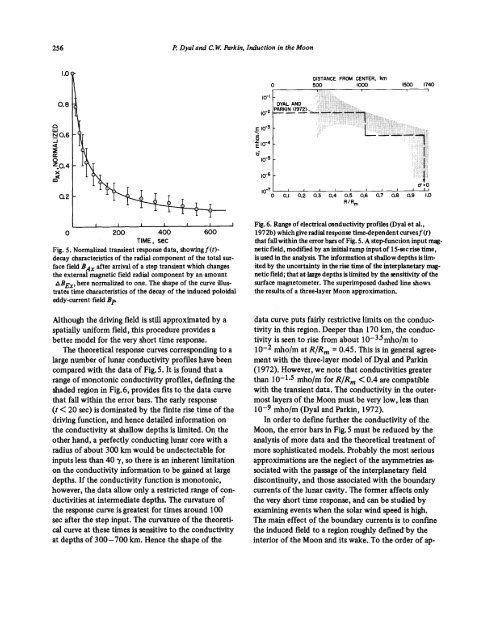global electromagnetic induction in the moon and planets - MTNet
global electromagnetic induction in the moon and planets - MTNet
global electromagnetic induction in the moon and planets - MTNet
You also want an ePaper? Increase the reach of your titles
YUMPU automatically turns print PDFs into web optimized ePapers that Google loves.
256 P. Dyal <strong>and</strong> C. W. Park<strong>in</strong>, Induction <strong>in</strong> <strong>the</strong> Moon<br />
I.0<br />
IO~<br />
0 8 DYAL AND<br />
~O6<br />
DISTANCE FROM CENTER, km<br />
0 500 000 500 740<br />
10 ~ PARKIN(I972)~~<br />
E10 3<br />
b<br />
0 I0~<br />
204<br />
- 0 0.1 0.2 0.3 0.4 0.5 0.6 0.7 0.8 0.9 .0<br />
- R/Rm<br />
I I I I -‘ Fig. 6. Range of electricalconductivity profiles (Dyal et al.,<br />
0 200 400 600 1972b) which give radialresponse time-dependentcurvesf(t)<br />
TIME, sec that fallwith<strong>in</strong> <strong>the</strong>error barsof Fig. 5.-A step-function <strong>in</strong>put mag.<br />
Fig. 5. Normalized transientresponse data, show<strong>in</strong>g f(t)- netic field, modified by an <strong>in</strong>itialramp <strong>in</strong>putof 15-sec risetime,<br />
decay characteristics of <strong>the</strong>radial component of <strong>the</strong> total sur- is used <strong>in</strong> <strong>the</strong>analysis. The<strong>in</strong>formation at shallowdepths is limface<br />
field BAX after arrival of a step transient which changes itedby <strong>the</strong>uncerta<strong>in</strong>ty <strong>in</strong> <strong>the</strong>risetime of <strong>the</strong> <strong>in</strong>terplanetary mag<strong>the</strong><br />
externalmagnetic field radial componentby an amount netic field;that at largedepths is limitedby <strong>the</strong> sensitivity of <strong>the</strong><br />
~BEx,here normalized to one. Theshape of <strong>the</strong> curve illus- surface magnetometer. The superimposeddashedl<strong>in</strong>e shows<br />
trates time characteristics of <strong>the</strong> decayof <strong>the</strong> <strong>in</strong>duced poloidal <strong>the</strong> results of a three-layer Moon approximation. -<br />
eddy-current fieldB~<br />
Although <strong>the</strong> driv<strong>in</strong>g field is still approximatedby a data curve puts fairly restrictivelimits on <strong>the</strong> conducspatially<br />
uniform field, this procedure provides a tivity <strong>in</strong> this region. Deeper than 170 km, <strong>the</strong> conducbetter<br />
model for <strong>the</strong> very short timeresponse. tivity is seen to rise from about lO33mho/m to<br />
The <strong>the</strong>oretical response curves correspond<strong>in</strong>g to a 10—2 mho/m at R/Rm = 0.45. This is <strong>in</strong> general agreelarge<br />
number of lunar conductivity profiles have been ment with <strong>the</strong> three-layer model of Dyal <strong>and</strong> Park<strong>in</strong><br />
compared with <strong>the</strong> data of Fig. 5. It is found that a (1972). However, we note that conductivities greater<br />
range of monotonic conductivity profiles, def<strong>in</strong><strong>in</strong>g <strong>the</strong> than 10—1.5 mho/m for R/Rm

















